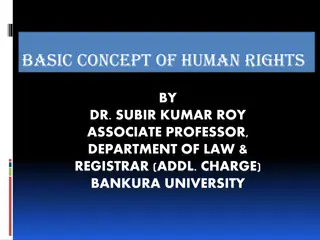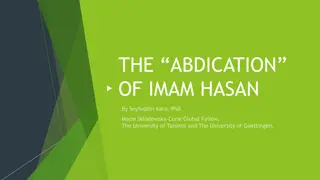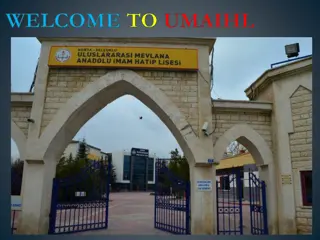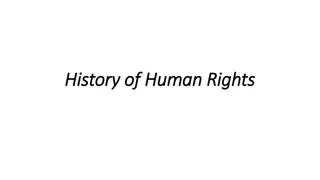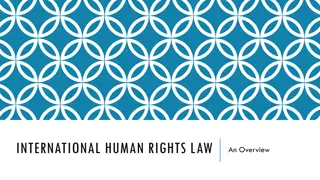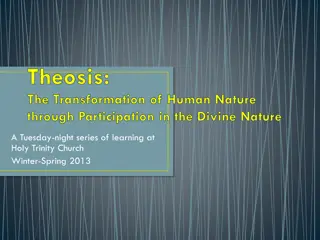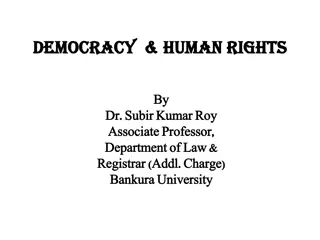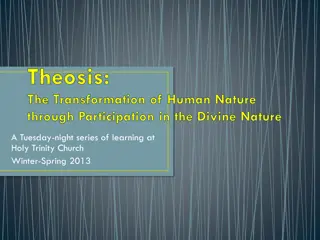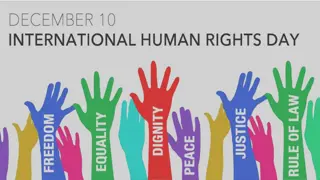Divine Perspective on Human Rights: Imam Sajjad's Vision
Workshop delves into Imam Sajjad's perspective on human rights, highlighting his life amidst challenging socio-political conditions and the legacy he left behind. Explore the themes of freedom, conscience, and defending human rights from a religious viewpoint.
Download Presentation

Please find below an Image/Link to download the presentation.
The content on the website is provided AS IS for your information and personal use only. It may not be sold, licensed, or shared on other websites without obtaining consent from the author.If you encounter any issues during the download, it is possible that the publisher has removed the file from their server.
You are allowed to download the files provided on this website for personal or commercial use, subject to the condition that they are used lawfully. All files are the property of their respective owners.
The content on the website is provided AS IS for your information and personal use only. It may not be sold, licensed, or shared on other websites without obtaining consent from the author.
E N D
Presentation Transcript
A Divine Perspective on Human Rights from the Viewpoint of Imam Sajjad
OPENING REMARKS At the outset, I would like to present my thanks and appreciation to the organizers of this 2023 Conference of the Parliament of the World s Religions for convening this world-wide Conference.
Human Rights in 2023 Conference of PoWR The Parliament of the World s Religions which is the oldest, the largest, and the most inclusive gathering of people of all faith and traditions has a great task of interfaith dialogue and coexistence between different religions. Focus of this Workshop: Consideration of Human Rights from Different Perspectives
Human Rights from a Religious Perspective The topic of my workshop is: A Divine Perspective on Human Rights from the Viewpoint of Imam Sajjad, which is in line with the theme of the conference which is: A Call to Conscience: Defending Freedom and Human Rights
IMAM SAJJAD (peace be upon him) Who is Imam Sajjad and the Circumstances he lived in Background: Imam Hussain, the 3rdImam of the Shia school of thought and the grandson of Prophet Muhammad, was martyred in Karbala because he did not pledge allegiance to Yazid, the cruel ruler of his time.
IMAM SAJJADS LIVING CONDITIONS Imam Sajjad, the son of Imam Hussain, was a living embodiment of the events of Karbala. He was in Karbala and witnessed brutal killing of his father, brothers and many close relatives and friends.
IMAM SAJJADS SOCIO-POLITICAL CONDITIONS The socio-political conditions of the society had made life very difficult for Imam Sajjad. Because of the pressure on Imam Sajjad not to spread Islamic teachings to others, he chose to convey his message through prayers and supplications. This is the reason that he was known as the prostrating Imam.
THE PSALMS OF ISLAM The collection of Imam Sajjad s prayers and supplications is now available in English with the name of Al-Sahifah al- Sajjadiyyah (The Psalms of Islam). Reference for the Book: Al-islam.org
PROHIBITION OF NARRATING HADITHS Another point to mention was the prohibition of narrating the sayings of the Prophet and his successors which are called hadiths, by the rulers of the time because they did not want such culture of pious and religious people spread against their ruling ambitions.
IMAM SAJJADS WAY OF GUIDING THE PEOPLE In such circumstances, which was one of the most crucial stages in the Islamic history, Imam Sajjad decided to guide his people from the moral decline that had corrupted the society.
IMAM SAJJADS CIRCUMSTANCES The ruling class kept people in an ideological and political vacuum while preventing the spread of Islamic as well as academic knowledge. They also prevented people to meet the true religious scholars and the Imams from the progeny of the Prophet of Islam.
PRAYERS AND SUPPLICATIONS Therefore, Imam Sajjad chose to convey his messages and teachings to his Shia followers and other interested individuals through prayers and supplications.
IMAM SAJJADS TREATIES OF RIGHTS The Treaties of Rights has been written in such suffocating atmosphere of oppression and injustice.
Divine Perspective on Rights based on Logic and Reason Imam Sajjad has considered the concept of Rights from a Divine perspective, based on the philosophy of ethics and moral issues.
TREATIES OF RIGHTS BY IMAM SAJJAD Imam Sajjad s Treaties of Rights has divided rights into the following categories: 1) Rights of God, 2) Rights of People (Mother, Father, Children, Teacher, Student, relatives, neighbors, etc.), 3) Rights of human body parts (eyes, ears, tongue, hands, feet, etc.) and 4) Deeds and Actions (helping the poor, giving alms, praying, fasting, etc.)
RIGHTS OF GOD Imam Sajjad s Treaties of Rights Rights of God The right of God to you is that you should worship Him and do not associate anyone or anything with Him. If you respect these rights sincerely, God has promised to reward you both in this world and in the Hereafter and provide you with whatever you like.
RIGHTS OF THE PEOPLE 2.1) Rights of your teacher: is that you should respect your teacher with dignity and honor. You should listen to him/her carefully and assist him/her in teaching by providing your intellect and thoughts in the teaching process.
RIGHTS OF SPOUSE 2.2) Rights of Spouse: is that you should realize that God has created your spouse so that you have a comfortable life filled with tranquility and peace of mind. Each one of you should thank God for providing you with such a blessing. You should respect each other s rights by being kind to each other with good manners.
RIGHTS OF MOTHER 2.3) : You should note that your mother has protected you whole-heartedly and has carried you in a place where no one else could do so. She has breast-fed you in a way that no one else would be able to do.
RIGHTS OF FATHER 2.4) : You should note that your father is the root and you are the branch. You should be thankful to your father for providing you with so much blessings.
RIGHTS OF CHILD 2.5) Rights of your Child You should note that your child is a part of you and is always referred to you whether he does good or bad. You are responsible for raising your child in the path of Allah and with good manners and behavior.
RIGHTS OF NEIGHBOR 2.6) Rights of your neighbor The neighbor s right is that you should treat him/her with dignity and respect and protect his/her belongings in his/her absence. You should help your neighbor at the time of hardship and be patient with him/her. Even if your neighbor did something wrong, you should act with forgiveness and moderation.
RIGHTS OF THE ELDERLY For 2.7) Rights of the elderly Rights of the elderly are that you should treat them with respect and if they have some Islamic virtues, you should give priority to them and honor them for that. Even if the elderly does something wrong, you should not quarrel with him/her. Several other examples have been mentioned by Imam Sajjad (as) in the Treaties of Rights .
RIGHTS OF THE BODY PARTS 3.1) Your own right You should dedicate yourself to obedience to Allah and ask Him to be able to fulfill the rights of your body parts which include the rights of your tongue, ears, eyes, hands, feet, stomach, and genital organs.
RIGHTS OF THE TONGUE 3.2) Right of the Tongue Is that you should respect your tongue by keeping it from bad language and make it a habit of using the right language. Use your tongue only when some benefits for your religion or your worldly life are involved. You should protect your tongue from vain language because your tongue is a sign of your intellect and good manners.
RIGHTS OF THE EARS 3.3) Rights of Ears Your ears are the gateway to your heart. Therefore, keep it away from listening to what has no benefits for you in this world and in the Hereafter.
RIGHTS OF THE EYES 3.4) Rights of Eyes You should not use your eyes to watch scenes which are forbidden according to the religious laws (Sharia). Your eyes are tools for learning and increasing your insight.
RIGHTS OF THE HANDS 3.5) Rights of Hands Your hands should be used in order to reach whatever is permissible to you. If you don t observe the right of the hands, you will be confronted with blame in this world and punishment in the Hereafter. If you use your hands in the path of Allah satisfaction and prevent it from any wrongdoings, you have acted wisely in this world and you will be rewarded in the Hereafter.
RIGHTS OF THE FEET 3.6) Your Feet Right of the feet is that you should not use them in the wrong path. Your feet are to carry you in the path of religion and development. 3.7) Your Stomach The right of your stomach is to place permissible food (Halal) in it and avoid what is forbidden. Even for the permissible food, you should eat moderately and avoid filling your stomach excessively because gluttony prevents you from active participation in fulfilling your duties
RIGHTS OF GENITAL ORGANS 3.7) Rights of genital organs In this regard, you should protect yourself and your body from the forbidden things. Remember death at all times. Fear God and emphasize on piety so that Allah shall help you to overcome all difficulties.
RIGHTS OF DEED AND ACTIONS In addition to the previous categories of rights, the rights of our actions are also considered by Imam Sajjad as follows: 4.1) Right of the Prayers Right of the prayer is that you realize that you are standing before Allah. Therefore, you should feel humble, submissive and fearful while you are performing your prayers.
FASTING 4.2) Fasting Right of fasting is that you realize that it is a guard and curtain before your tongue, ears, eyes, and vain desires for protecting you from the fire of the Hell. For the rights of deeds and actions other examples have been mentioned in the Treaties of Rights by Imam Sajjad (as).
Summary of Treaties of Rights Imam Sajjad has specified Rights of God (Creator of man and all other creatures) and rights of human beings from a Divine Perspective. The comparison between the Treaties of Rights and Universal Declaration of Human Rights (UDHR) makes a clear distinction between the two approaches to human rights (from a Divine perspective and from the minds of selected human beings and thoughts)
THE UNIVERSAL DECLARATION OF HUMAN RIGHTS The Universal Declaration of Human Rights (UDHR) is a milestone document in the history of human rights. Drafted by representatives with different legal and cultural backgrounds from all regions of the world, it set out, for the first time, fundamental human rights to be universally protected
THE UNIVERSAL DECLARATION OF HUMAN RIGHTS Is universal in insight but fails its mission to be particular in implementation. The main eight ratifiers of the UDHR were the representatives of 18 countries from certain countries Despite the multiple authorship of the UDHR, particularism was not achieved. Use of abstract terms results in ambiguity and multiple interpretations Contains both conditional and absolute rights. The use of indefinite pronouns, like everyone and no one, in the UDHR is what has made it a less authoritative announcement of rights and more ambiguous in terms of implementation
Imam Sajjads Rights Treatise Written in a style that is closely related to actual issues of life. Is not based on nation states and their boundaries, but on human nature and philosophy of moral and ethical norms and values as identified by God. Avoids abstract terms The organization of the Rights Treatise starts with the rights of the individual human being and moves to social rights. Tone persuasive Moral in nature Dialogical narrative style reciprocity of rights and duties Contains both conditional and absolute rights. The use of the second-person pronoun has made it more applicable to individual human beings
Reciprocity of Rights Another exclusive characteristic of Imam Sajjad s Treatise is its emphasis on the reciprocity of rights. Imam Ali, the first Imam of the Shia school of thought, and Imam Sajjad s grandfather, said in a sermon: There is no one person with a right, unless he himself is obliged by another person s right upon him. Wesley Hohfeld s description of rights also refers to the reciprocity of rights: Hohfeld characterized a right as a relation between two parties. Thus, he held that, for every type of right, there must be a correlative term describing the position of the other party in the relation. - Quoted in Jones (n 20) 13
Treaties of Rights Samuel Moyn even suggests that the human rights awareness and mobilization did not start in the 40s and by the UN, but started in the 60s and 70s, when the previous human rights endeavours or prior utopias failed. What is the reason for the failure of human rights attempts? The rational-religious elements are missing in the human rights declarations. When we refer to Shia Islam s definition of human rights, and more specifically to Imam Sajjad s Rights Treatise which was written during 570 AD to 874 AD, in order to write a comprehensive declaration we should consider both physical and metaphysical traits, to accompany the rational investigation of human needs.









